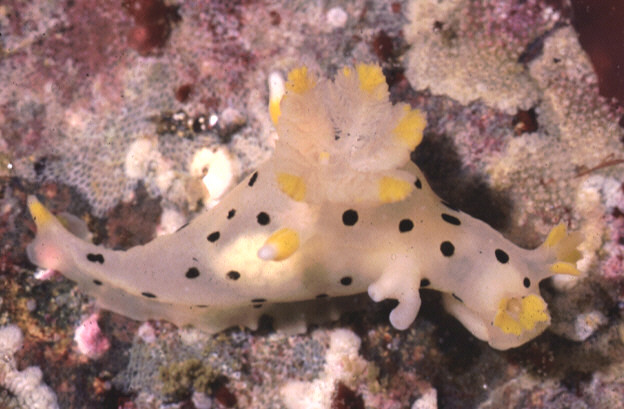
Thecacera darwini
Thecacera darwini Pruvot-Fol, 1950
In 1845, Charles Darwin was off the Chilean coast of South America.
As ships naturalist on the Beagle he collected a variety of species which
were then farmed out to specialists or housed in museums. As far as we
know, only one nudibranch species was collected by him, and its fate is now
unknown. However, it was mentioned twice in the literature, first by Alder
& Hancock (1855), who identified it as a species of Thecacera collected by
Darwin in the Chonos Archipelago, southern Chile and then by Bergh (1883)
who listed the undescribed species.
It took one hundred and five years before the Frenchwoman, Alice
Pruvot-Fol, found on the shelves of the Natural History Museum in Paris
several jars of Thecacera from Isla Hoste, Chile, and described the species
which she named in honor of Charles Darwin. The color of these preserved
species was unknown and although Ernst Marcus (1959) redescribed the
species, he could only add that it had spots and yellow edgings. Now,
thanks to Michael Schroedl, who recently published a photograph and
contributed this one to slug site viewers, we see this common Chilean
species in its true splendor.
Thecacera, is a small genus in the family Polyceratidae with only six known species . They are visibly distinguished by having no frontal veil or oral tentacles and by having contractile rhinophores with incomplete sheaths and unbranched appendages on each side of the non-retractable gills. The species are found mainly in tropical waters, although the cold temperate Thecacera darwini is an exception. Reaching a size of 45 mm, Thecacera darwini advertises its presence with a white body and contrasting black spots. Golden yellow pigment tips the perfoliate rhinophores, papillate edges to the rhinophore sheathes and the five tripinnate gills.The extra branchial appendages, which are believed to be defensive, have white bases, a strong band of golden yellow and opaque white tips. Golden yellow lines are on either side of the tail and its tip. The Y shaped protrusion behind the rhinophore bears the genital openings, the male opening , which has an eversible spiny penis is anterior to the female.
This animal is extremely visible in the shallow subtidal and on the sides of salmon farm floats, where it feeds on the bryozoan Beania magellanica. Its body contains the chemical triophamine, which probably deters predators.
The known range of this species is from Juan Lopez, near Antofagasta, northern Chile (Schroedl, 1996) to Isla Hoste, off the Chilean side of Tierra del Fuego (Pruvot-Fol, 1950).
Text courtesy of:
Sandra Millen
Department of Zoology
University of British Columbia
Vancouver, B.C., Canada, V6T 1Z4
Phone (604) 822-2087; Fax (604) 822-2416
Send Sandra E-Mail at millen@zoology.ubc.ca
or visit Sandra's Home Page
Michael Schroedl
Zoologisches Institut der Ludwig Maximilians-Universitat Munchen
Abt. Prof. Bohn, Karlstr. 23, 80333 Munchen, Germany
phone (49-89) 5902-312, fax (49-89) 5902-405
Send Michael e-mail at schroedl@zi.biologie.uni-muenchen.de
For those of you interested in the photographic background information of the images, the following may be of interest!
Site: Dichato, Bahia de Coliumo, Central Chile
.
Camera System: Minolta X700
Strobe: Natural light, bucket photo
